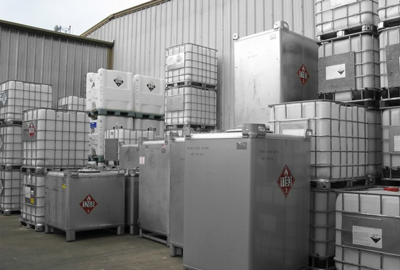7 Tips For Distributors To Practice Chemical Logistics Safety
by Lynn Place
 In the world of hazardous chemicals, moving and storing are among the most dangerous steps if done without the right preparation. You have to consider corrosiveness, combustibility and reactivity with other chemicals. What’s more, you can’t always count on the container itself to prevent spillage.
In the world of hazardous chemicals, moving and storing are among the most dangerous steps if done without the right preparation. You have to consider corrosiveness, combustibility and reactivity with other chemicals. What’s more, you can’t always count on the container itself to prevent spillage.
Adherence to regulations is a good start, but it’s up to the facility manager and individual employees to take every last precaution. Below are seven important tips to significantly reduce workplace injury.
1) Maintain Your Tools
Just as important as your storage containers are the tools you use to move and store them. Faulty tools could break or malfunction, causing workers to lose their grip or lose control over a chemical drum entirely. Similarly, storage racks, pallets and trays should be thoroughly inspected for any signs of damage. Even a small crack can result in a catastrophic chemical spill.
Daily inspections can make all the difference. Employees should know the obvious signs of damage. They should also be able to identify warning signs by sight, sound and smell. It is also important for employees to know when a tool is beyond repair and should be discarded entirely.
2) Have the Right Personal Safety Equipment
In a warehouse, not all personal safety equipment is the same. Your workers might have access to work gloves, helmets for impact, and maybe even safety goggles. Chemical handling requires a bit more: Workers who risk exposure to hazardous chemicals should be covered from head to toe when possible. That means gloves specifically resistant to your chemicals, work helmets with visors, and clothing properly designed to protect against splashes. Personal safety equipment also means access to chemical-specific response, such as eyewash stations, fire extinguishers, drench showers and first-aid kits.
3) Make Your Labeling Very Clear
Every item in the chemical warehouse should be clearly labeled. Labels should include chemical information (such as potential reactions with other chemicals), storage instructions and specific destination details. Labels should also be large and legible so that any worker in the vicinity can quickly know the risks. It also helps to have labels available in multiple languages.
4) Keep a Close Eye on Air Flow
In almost no other industry is ventilation as important as in chemical handling and storage. Chemicals can emit gases — oftentimes odorless — that can build up quickly if not properly ventilated. As such, any facility that houses chemicals, from laboratory to warehouse, should be designed for optimal airflow. A working exhaust system should be able to flush out a room’s air at least 10 times per hour as needed. Monitoring systems should also be installed throughout your facility to quickly identify air-quality risks so that workers can immediately evacuate.
5) Increase Space as Much as Possible
It’s a tall order, but it’s also an important one. Smaller spaces increase risk, especially when chemicals are involved. Your workers should have plenty of room to move and store chemicals safely, and they should have an easy, clear way to exit the facility in the event of a chemical emergency. Maintain strict capacity guidelines within your company, and take care not to overstuff your storage or workspace if you can help it.
6) Communicate Your Emergency Response Plan
Over time, it’s almost inevitable that a chemical spill will occur in your facility. While prevention should be a top priority, be careful not to overlook your response plan. Your plan should include instructions for safe evacuations, steps to contain the problem when possible, and instructions for seeking medical attention. Practice is key. Perform routine drills (more than what is legally required, if you can) to help ensure that your emergency response procedures don’t make matters worse.
7) Train Everyone — Again and Again
At the end of the day, facility safety depends on individual knowledge. Every worker who comes in contact with chemicals — and even those who rarely do — should have a deep understanding of the risks, how to reduce them and how to respond. Offer regular training courses, and post information throughout your facility.
While the seven steps above cannot completely eliminate risk, they can lay the groundwork for safer operations. As facility manager, it is your responsibility to go above and beyond to keep all of your workers safe.
 Lynn Place has 30 years of professional experience in the manufacturing, market research and advertising industries. As Vice President of Marketing for SolvChem Custom Packaging Division, Place specializes in consumer packaged goods, new product development and strategic planning.
Lynn Place has 30 years of professional experience in the manufacturing, market research and advertising industries. As Vice President of Marketing for SolvChem Custom Packaging Division, Place specializes in consumer packaged goods, new product development and strategic planning.
Source
http://www.inboundlogistics.com/cms/article/chemical-logistics-keep-it-moving-keep-it-safe/












